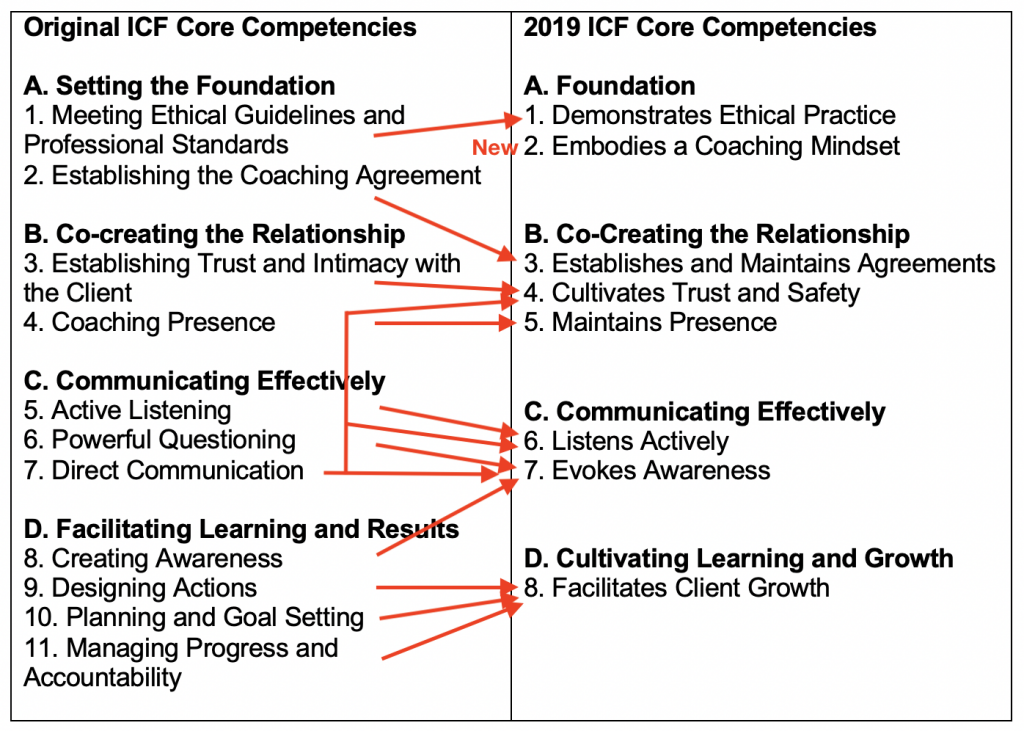The International Coaching Federation updated the Coaching Core Competency Model in October 2019. What’s the same and different? More importantly, how might your coaching need to change in order to meet these new standards?

The International Coaching Federation (ICF) is the world’s largest coaching association, by far. They set the standard for the professional coaching industry by providing a Code of Ethics, coaching Core Competencies, coaching training program approvals, and certification of individual coaches.
After nearly 25 years, the ICF has completed a rigorous 2-year process to research and analyze coaching best practices. You can read about the process here.
A Revision, Not A Revolution
The new ICF Core Competencies looks very familiar. (To read the new competencies go here and scroll down to the updated competencies.)
One person familiar with the updating process called the result “a revision, not a revolution.” There is change, but it confirmed much of the previous practice.
Here’s my big-picture comparison the competencies, old and new:

At a broad view here’s what’s noticeable:
- There’s a new competency called: 2. Embodies a Coaching Mindset.
- 7. Evokes Awareness encompasses the previous Powerful Questioning, Creating Awareness, and some of Direct Communication.
- Direct Communication is no longer a separate competency but shows up as sub-points in competencies 4, 6, and 7.
- 8. Facilitates Client Growth encompasses the previous Designing Actions, Planning and Goal Setting, and Managing Progress and Accountability.
10 Great Changes to the ICF Core Competencies
There’s a lot to like about the new ICF Core Competencies.
If you coach using The COACH Model®, then you are already doing much of the ICF Core Competencies. The updated ICF Core Competencies validate what The COACH Model® has expressed since 2004.
A few areas where there are noticeable improvements in the core competencies are:
- Concise. There are now 8, not 11 Core Competencies. It’s concise in more than just in the number of competencies but also in the overall number of words. It also reads more clearly.
- Action words. Each competency and sub-point are written behaviorally with action words beginning each sentence. This better frames expectations of the coach’s behaviors.
- Being and doing. Competencies 1 and 2 mostly describe the coach and the coach’s state of being – their ethics, mindset, and professionalism. The six other competencies are doing-related – describing the coach’s behavior.
- Ongoing learning. There is a new competency, 2. Embodies a Coaching Mindset, which highlights the importance of the coach’s ongoing learning and reflective practice. Check out our tool called The Reflective Journal for Coaches to assist you in self-reflection and ongoing learning.
- Cultural, systemic, and contextual awareness. Three times the new competencies mention, the “client’s identity, environment, experiences, values and beliefs.” Coaches must understand their own cultural shaping (mentioned in 2. Embodies a Coaching Mindset, sub-point 4) and the effects of culture on the client.
- Two types of coaching agreements. The previous competency, Establishing the Coaching Agreement, only addressed the overall coaching relationship. The new one, called, 3. Establishes and Maintains Agreements, provides standards for the coaching relationship and individual sessions. This is long overdue. Outcome from The COACH Model® does a thorough job of exploring the client’s agenda.
- Integrating Direct Communication. The competency Direct Communication was often not understood or misused. Coaches do more than just ask questions. We notice and share without attachment. The new competencies do not have a separate competency for direct communication, but continue the practices of it in 4.6, 6.4, 6.6, 7.2, and 7.11.
- Partnering language. A coaching conversation is not “led” by the coach. Client and Coach partner together to determine every step of the way. The updated competencies add partnering language throughout to emphasize this dynamic.
- Learning and insights into action. The final three competencies from the original list have 24 sub-points. These have been successfully boiled down to just eight in the new 8. Facilitates Client Growth. An emphasis on client autonomy in choosing goals, actions, plans, and accountability is added.
- Follow-up and Highlights. The final step of The COACH Model® is Highlights, when the client is asked to share their learning and insights from the conversation. We teach following-up action steps as part of the initial Connect in the conversation. Both of these practices are now in 8.6: “Partners with the client to summarize learning and insight within or between sessions.”
I’m pleased with the updated ICF Core Competencies, particularly their increased clarity and brevity. Not all the wording is exactly what I would choose, but overall, the Competencies will be better understood and easier to follow.
Leave a comment or share this article.


Please note: I reserve the right to delete comments that are offensive or off-topic. You own your comments but give me permission to use them. See My Comments Policy. Read my Permissions Policy to know how you can use my posts.